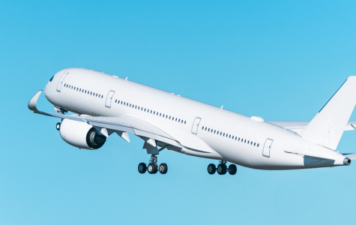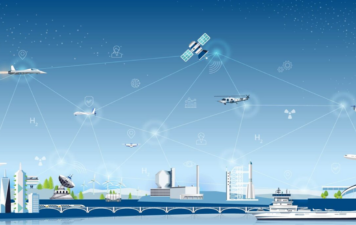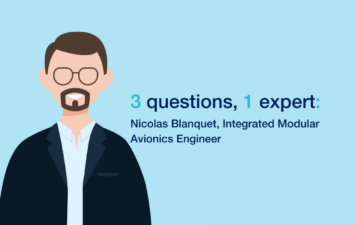 Safety
Safety Women In Stem: Francesca Popescu, ATM/UTM Team Leader and Line Manager

Francesca joined Airbus Protect as an ATM/UTM Safety Engineer three years ago. Since
then, she’s risen to become an ATM/UTM Team Leader and Line Manager.
In this interview, Francesca talks about her career in aerospace, and within Airbus Protect.
Francesca joined Airbus Protect as an ATM/UTM Safety Engineer three years ago. Since then, she’s risen to become an ATM/UTM Team Leader and Line Manager. In this interview, she talks about her career in aerospace, and within Airbus Protect.
Tell us about your professional journey to date.
It all started when I first flew a glider – that was when I realised that I wanted to work in the aerospace industry.
To make this dream a reality, I embarked on a bachelor’s in engineering in Romania, majoring in air navigation. I then travelled to France to continue my studies, starting a master’s program at ENAC (Ecole Nationale de l’Aviation Civile) to enhance my aerospace industry knowledge.
During both my degrees, I consolidated my theoretical knowledge while gaining some practical experience through internships that focused on safety challenges the aerospace industry was facing at the time.
Thanks to my internships, I obtained a position as a Flight Operations Engineer, which lasted around two years. This enabled me to understand the link between the technical constraints for systems design and the operational needs of airlines. This experience made me want to understand the system design process better, so I embarked on an almost three-year journey working as a System Design Engineer.
Three years ago, I got the opportunity to join Airbus Protect to work on safety activities for ATM (air traffic management). I gladly accepted this new challenge, bringing me back to my educational roots.
In the last three years at Airbus Protect, I’ve been very busy developing our safety expertise for the ATM ecosystem and investigating the impact of UTM (unmanned aircraft system traffic management) on ATM and its safety consequences. A year ago, I also took on the challenge of leading a group of 12 safety engineers and ensuring their needs are met. Moreover, I’m the focal point of our technical community, which aims to harmonise and showcase the safety consulting business unit’s skills within Airbus Protect. These experiences have helped me develop myself not only technically but also on a personal level.
Did you face any particular challenges when starting your career in aerospace?
The aerospace industry provides a challenging setting from both a technical and personal perspective. Taking accountability for your work is important, starting from your first internship. I learned this quickly.
Within the companies I previously worked at, my work impacted several stakeholders at several levels. As such, my responsibility was to make sure that my work considered the impact and benefits for all stakeholders (internal and external). As part of this, I ensured that technical questions were addressed in an acceptable time frame for all stakeholders and that all parties were kept in the loop of the responses.
My current role offers me a new palette of challenges, such as developing our expertise in other aerospace industry perimeters, coordinating internal ‘competency development’ processes and ensuring that people are the centre of any transformations or actions we take.
What do you enjoy most about your job?
Definitely the diversity of my roles with Airbus Protect! Thanks to this, I get to work on the technical subjects that I enjoy the most, such as safety applied to the ATM and UTM ecosystems. I also get to be involved in the technical transformation of the safety consulting business unit through my role as Technical Community Leader. Last but not least, I get to work with people and ensure their development within the safety team I lead.
What keeps you interested in safety?
In my opinion, safety is simply common sense. Of course, if we take an in-depth view, it’s more than that, but employing sound, practical judgment is crucial to assessing situations or circumstances shrewdly and drawing sound conclusions.
Safety lets you take advantage not only of your technical skills but also your soft skills. As safety engineers, we strive to gather all elements of interest and interact with all key stakeholders to better identify unacceptable risk levels when deploying a safety analysis. We often face situations where not only do we need to demonstrate the results of our assessments, but also support and explain our findings in a concise and clear manner for the subject audience.
What new skills have you been able to develop since joining Airbus?
I would like to think that I now better understand safety methodologies and how we apply them in different fields. I’ve also learned how to better adapt my communication approach depending on the target audience. Moreover, I am still learning how to work on transversal activities which interact with different levels of responsibility within Airbus Protect.
What advice would you give to somebody who wants to work as a safety engineer?
Be open to experiencing new challenges and trying new things!
My journey within Airbus Protect is very particular and might not apply to everyone. Nevertheless, I’m a firm believer that if you’re a curious person and like being part of shaping a new approach to safety, cybersecurity and sustainability, then Airbus Protect is a great place to do this!
Interested in pursuing a career in aerospace? Check out the current job openings in Airbus Protect’s safety consulting business unit.
- Share
More on Safety
 Safety
Safety  Safety
Safety Safety 101: Understanding operational reliability terminology
MBSA, SMS, ATM… Do you understand all the acronyms in the safety environment? If not, don’t worry. Here’s your guide.
Read more Safety
Safety 3 questions, 1 expert: Nicolas Blanquet, integrated modular avionics engineer
Want to learn more about day-to-day work of an avionics engineer? Meet Nicolas, a module integration architect at Airbus Protect’s Toulouse site.
Read more
